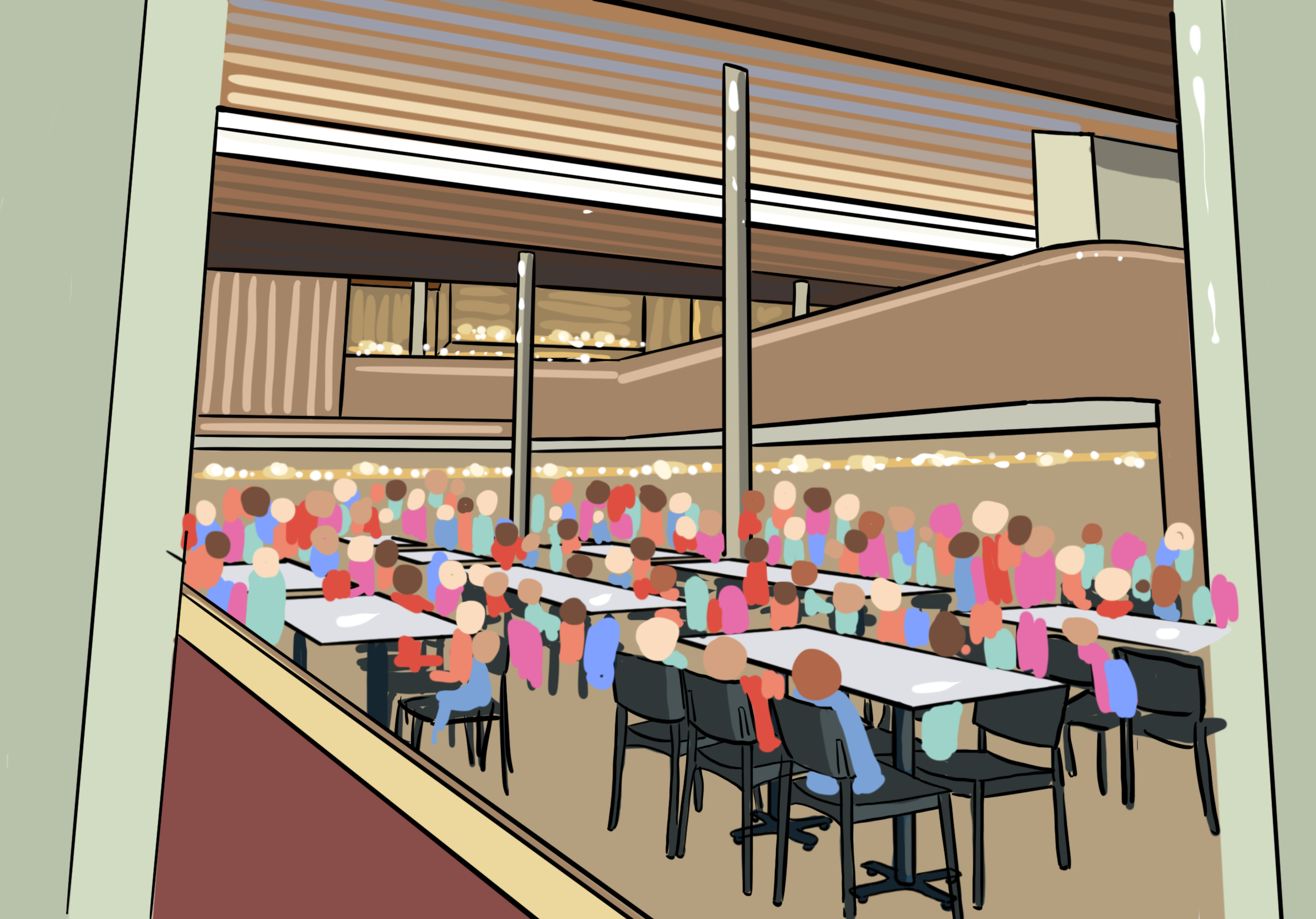Saturday, December 21
Give Change a Chance: Why We Shouldn't Discount Tsai Just Because We Can't Find the Napkins
Sathvik Samant ’26 in Opinions | September 30, 2022

Tsai Commons, Lawrenceville’s long-anticipated new dining hall, made its grand debut last week. Within its sleek brick facade and iconic arched roof lies a brand new, modern facility with expansive double-height ceilings, an open concept design, and, most importantly, taller glasses. Tsai, Lawrenceville’s newest addition to campus, has fully replaced the Irwin Dining Center, a cozy (albeit aging) dining hall where generations of Lawrentians have shared meals with friends and teachers. Our transition from Irwin to Tsai has been a reluctant one; many Lawrentians miss the comforting familiarity of Irwin. Yet what we fail to realize is that Tsai and Irwin are simply buildings—what gives them their value is not their construction, but the memories, conversations, and laughter that we share within them.
The cozy, cabin-like feel of Irwin, a result of a combination of red brick and oak in its construction, was present throughout the building, from its dark foyer to the hexagonal pods that dotted the upper floor. Its tables, cramped and close together, were old and worn, and its chairs rang with a familiar squeak. We instinctively knew where the salad bar was, how to operate the wok burners, and which bins were which in the clearing station. When we sat in Irwin, we could feel the presence of generations of Lawrentians before us; all we had to do was look up to see the forks that dotted the ceilings. We all had our first Lawrenceville meal in Irwin—we made our first omelet and met our first friends within its walls. This comforting familiarity that Irwin radiates goes far beyond its cozy interiors. Rather, it lies within the memories, meals, and meetings inside; the laughter, the joy, the tears.
Now, the familiar coziness of Irwin is gone, replaced by the sterile modernity of Tsai. Tsai’s towering ceilings, reminiscent of an Amazon warehouse, create the illusion of a massive, almost uninviting space. The large windows let in cool light, illuminating the dining hall with a monotonous glow. The cozy cabin-like paneling, warm lighting, and cramped yet comfortable spaces have been left behind in Irwin. Tsai, basked in a constant sterile light, seemingly lacks the familiarity that Irwin possessed. It’s difficult to imagine forging those same connections that we did in Irwin in such a space.
Yet despite its unfamiliarity, Tsai’s open concept space fosters and encourages community. Irwin’s hexagonal pods separated Houses from each other, physically separating our community and hindering new interactions and relationships. Sitting in Griswold pod, you would rarely, if ever, catch a glimpse of someone sitting in Kirby pod. On the other hand, Tsai adopts an open layout with large rectangular tables, spread evenly throughout the space. The design encourages whole school interconnectedness—when we are able to see everybody at once, we lend potential to new relationships, exciting interactions, and a stronger Lawrenceville community.
Although II Formers still have a separate dining area, unlike the Lower Dining Hall in Irwin, the mezzanine level of Tsai is open, overlooking the III and IV Formers below. In contrast to the stark separation in Irwin, the mezzanine area is filled with the wandering chatter of upperclassmen. On the way to lunch, II Formers can exchange waves with their older peers, once again promoting whole-school togetherness. Irwin separated II Formers, hindering the development of interform relationships that Tsai champions. In fact, every aspect of Tsai’s construction and design encourages community values—the building is like an empty memory card waiting to be filled. Both above and below, Tsai offers more space for Lawrenceville's growing community to enjoy meals together.
Fond memories from Irwin will remain in many Lawrentians' minds—advisories, meals with friends, buying ramen at the Jigger Shop. What we must recognize is that these pleasant memories are unattached to the building itself; instead, they lie within the Lawrentians who made them. Despite being replaced by Tsai, the well-loved Irwin will always be home to countless memories. Tsai, given time, will also house valuable memories of laughter, joy, tears, excitement, and more. At the end of the day, Tsai and Irwin are simply buildings—shells of concrete and steel. Housed within them, however, are the people who make Lawrenceville whole.
Related Articles
- Satellites for Climate Change? Seriously? Sophie Liu ’27
- Sinking and Swimming | New Student Reflection Irene Fu ’27
- Your Move, NATO. Ellen Jordan ’26
- Senate Bill 1329 Fails Idaho Minors Tiffany Sun ’26
- AI Legislation Woefully Inadequate Matthew Fu ’27
Recent Articles
- Chill Fashion: Tips from the Pros Michael Meng ’26
- Deck the Houses! Holiday Cheer Sprawls Across Campus Ellen Jordan ’26
- Lessons and Carols: Tuesday Evening Vivian Blessing ’27
- The Past, Present, and Future of The Disciples Angel Xin ’26
- For the Love of Latin Aileen Ryu ’25